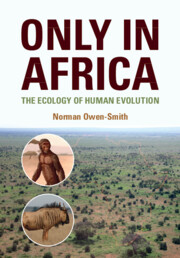Book contents
- Only in Africa
- Only in Africa
- Copyright page
- Dedication
- Contents
- Foreword
- Preface
- Abbreviations
- Part I The Physical Cradle: Land Forms, Geology, Climate, Hydrology and Soils
- Part II The Savanna Garden: Grassy Vegetation and Plant Dynamics
- Part III The Big Mammal Menagerie: Herbivores, Carnivores and Their Ecosystem Impacts
- Chapter 10 Niche Distinctions: Resources Versus Risks
- Chapter 11 Big Fierce Carnivores: Hunting Versus Scavenging
- Chapter 12 Herbivore Abundance: Bottom-up and Top-down Influences
- Chapter 13 How Large Herbivores Transform Savanna Ecosystems
- Chapter 14 Paleo-faunas: Rise and Fall of the Biggest Grazers
- Part III Synthesis: Movers of Savanna Dynamics: Grazers, Elephants and Fires
- Part IV Evolutionary Transitions: From Primate Ancestors to Modern Humans
- Appendix Scientific Names of Extant Animal and Plant Species Mentioned in the Book Chapters (Ecologically Conservative with Regard to Species Recognition)
- Index
- References
Chapter 12 - Herbivore Abundance: Bottom-up and Top-down Influences
from Part III - The Big Mammal Menagerie: Herbivores, Carnivores and Their Ecosystem Impacts
Published online by Cambridge University Press: 09 September 2021
- Only in Africa
- Only in Africa
- Copyright page
- Dedication
- Contents
- Foreword
- Preface
- Abbreviations
- Part I The Physical Cradle: Land Forms, Geology, Climate, Hydrology and Soils
- Part II The Savanna Garden: Grassy Vegetation and Plant Dynamics
- Part III The Big Mammal Menagerie: Herbivores, Carnivores and Their Ecosystem Impacts
- Chapter 10 Niche Distinctions: Resources Versus Risks
- Chapter 11 Big Fierce Carnivores: Hunting Versus Scavenging
- Chapter 12 Herbivore Abundance: Bottom-up and Top-down Influences
- Chapter 13 How Large Herbivores Transform Savanna Ecosystems
- Chapter 14 Paleo-faunas: Rise and Fall of the Biggest Grazers
- Part III Synthesis: Movers of Savanna Dynamics: Grazers, Elephants and Fires
- Part IV Evolutionary Transitions: From Primate Ancestors to Modern Humans
- Appendix Scientific Names of Extant Animal and Plant Species Mentioned in the Book Chapters (Ecologically Conservative with Regard to Species Recognition)
- Index
- References
Summary
This chapter compares the potential impacts of seasonal food abundance and predation risks on herbivore populations. It describes how herbivore species differ in their response to seasonal rainfall variation. Major droughts can induce severe population crashes. Abundant water accentuates local food depletion. Food shortages may cause animals to incur greater exposure to predation so that bottom-up and top-down influences are entangled. Demographic shifts may lower prey vulnerability to population growth rates, dependent on body size, and sustainable recruitment thresholds. Savanna ungulates differ in the breadth and seasonal timing of birth seasons. Medium–large grazing ruminants produce the most biomass annually. Browsers and equids are consistently less abundant than grazers, while smaller herbivores are more narrowly distributed regionally. Populations also expand and contract in their distribution.
Keywords
- Type
- Chapter
- Information
- Only in AfricaThe Ecology of Human Evolution, pp. 181 - 198Publisher: Cambridge University PressPrint publication year: 2021

